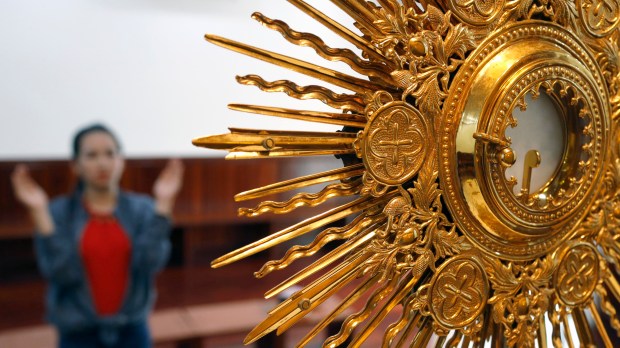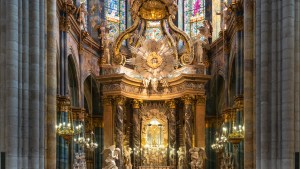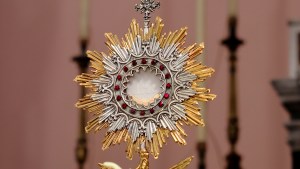Lenten Campaign 2025
This content is free of charge, as are all our articles.
Support us with a donation that is tax-deductible and enable us to continue to reach millions of readers.
Anjelo Rocero remembers the first time he encountered the ancient Catholic practice of Eucharistic adoration — at a youth conference, where organizers had the Blessed Sacrament exposed for attendees to sit or kneel in silent prayer.
As he grew in the Catholic faith, Rocero continued to encounter this devotional practice. But it was later, when he was studying neuroscience at Temple University, when it really took root in his life.
“Our chaplain made it very important that he would have Eucharistic adoration every single day from 8 a.m. to 5 p.m., and a lot of other students would sign up for those slots and would fill up the chapel,” said Rocero, 27. “It was through just being invited to spend an hour with the Lord and especially through some of the other FOCUS missionaries teaching me how to pray and what they do in adoration.”
FOCUS, the organization formerly known as the Fellowship of Catholic University Students, forms missionary disciples and is active at Temple. Rocero, who has served as a team director at Drexel University, said it was intimidating to start practicing adoration, but after a FOCUS missionary explained “what he does and how you can pray with Scripture and do lectio divina,” the practice caught on. (Lectio divina is a prayerful, meditative reading of Scripture.)
“In my work with FOCUS, I have seen so many students come to know Jesus through Eucharistic adoration,” Rocero said. The Newman Center at Drexel has a perpetual adoration chapel “where we consistently invite students to come and pray with us. There has been a growing amount of students who have been taking part in adoration,” with some taking turns during the overnight hours.
In that respect, Drexel is a microcosm of the wider Catholic young adult world in the U.S. and elsewhere. Whether it’s because young Catholics seem to have more time or are rediscovering a tradition that might have been neglected in recent years, Eucharistic adoration seems to be attracting more and more devotees in their late teens through 20s.
And it’s not only university students. In New York City, Dominican Fr. Boniface Endorf is pastor of St. Joseph’s parish in the Greenwich Village neighborhood of Manhattan, where young single professionals, young couples just starting careers and families, and students from nearby New York University make up the bulk of the congregation. The Dominican friars at St. Joseph’s also staff the Catholic Center at NYU. After the Young Adult Ministry of the Archdiocese of New York — responding to increasing calls from young people for round-the-clock availability of a place to pray in the presence of Christ in the Eucharist — asked Fr. Endorf if he’d be willing to build a perpetual adoration chapel at St. Joseph’s, separate from the main church, he set in motion plans to construct a Eucharistic chapel.
“It’s the students who ask me the most often about the project, who are the most eager for it to be completed. They’re the ones who, after Mass, ask, ‘When’s the chapel going to be done?” Fr. Endorf said. “I can see a generational shift, because in the parish many of the baby boomer generation are like ‘Well, if you really want it, okay,’ but essentially they don’t get it, why some people would be interested. … I imagine that when it’s built, probably most of the people in there will be people in their 20s and 30s, maybe younger.”
The gaze of Jesus
Timothy P. O’Malley, director of education at the University of Notre Dame’s McGrath Institute for Church Life, suspects that part of the reason for the devotion’s growing popularity is that “there was a pretty significant decline after the Second Vatican Council around adoration — primarily intentional.” So members of Generation Z and Millennials, who might not have been exposed to it growing up, have now been rediscovering it.
After Vatican II, O’Malley said, “the goal was to focus more on the Mass, and often adoration was placed to the side.”
Adoration’s increasing popularity since then is in part, “a critique of that previous assumption, that adoration was in competition with the Eucharistic Liturgy,” O’Malley said. “Two, there began to be more public expressions of that adoration, particularly in things like Worth Youth Day or in apostolic movements in the Church, so there began to be, again, more people participating in adoration.
“And three, I think the desire for it has arisen in a space that, as things got louder, with more noise and almost frenetic energy, there’s increasing spiritual interest in spaces that are quiet, where not a lot of things are happening,” said O’Malley, author of Real Presence: What does it mean and why does it matter?. “And adoration in a particular way meets that need. It is quiet. It’s not full of verbosity.”
There’s increasing spiritual interest in spaces that are quiet, where not a lot of things are happening.
Prof. Timothy P. O’Malley
Rocero said he enjoys an “overwhelming sense of peace” during the hour he sits in front of the Blessed Sacrament.
“Also, recently, I think I’ve started to pray a lot with the gaze of Jesus and seeing Him see me,” he said. “It’s like, I kind of describe it as a father who looks at his children, very intimately. I explained to my spiritual director that lately it’s hard to see the gaze of the Father in prayer, and he reminded me like time and time again to look at how parents look at their children and just imagine the Lord holding you and seeing you like that.”
Eucharistic revival
The trend among young people comes at a good time, from the standpoint of the Catholic bishops of the United States. The bishops are in the midst of developing a plan to revive Eucharist devotion among the flock and will be debating and voting on a guiding document on that topic this month at their annual meeting in Baltimore.
Bishop Andrew H. Cozzens, recently named bishop of Crookston, Minnesota, has been involved in planning for the so-called “Eucharistic revival.” At the November 15-18 fall general assembly of the United States Conference of Catholic Bishops, he and Bishop Kevin C. Rhoades of Fort Wayne-South Bend, Indiana, who chairs the USCCB Committee on Doctrine, will present a statement on the “meaning of the Eucharist in the life of the Church” and details of a national Eucharistic Congress planned for 2024. In an interview conducted through email, Bishop Cozzens agreed that adoration is “a very popular devotion among young adults who are active in their faith.”
“As Catholics, we know that the celebration of the Eucharist, or Mass as it is often referred to, is the ultimate prayer; it is the source and summit, as we say,” Bishop Cozzens said in the interview. “But the Eucharist is such a profound mystery that we need to spend time in adoration to receive all this mystery has for us, especially to open our hearts and minds to Jesus Christ and learn to respond to him fully with our hearts. Adoration opens the heart and mind to receive and respond to the gift of the Mass by allowing our hearts to receive the graces of the previous one and increasing our receptivity for the next one.”
Notre Dame’s O’Malley, who serves on the executive committee for Eucharistic revival in the Church in the United States, said the committee is addressing the increasing popularity of Eucharistic devotion among younger Catholics.
Declining belief?
Bishop Cozzens has said previously that the impetus for the bishops’ work on a Eucharistic revival was a 2019 Pew Research study that found 69% of Catholics don’t believe the Church’s teaching that Jesus is truly present in the Eucharist.
Specifically, the survey found that only a quarter of Catholics under 40 believe in transubstantiation.
Some experts, though, urge caution about the survey’s findings.
“We should be very suspicious of that study,” O’Malley said. “The language is very insufficient for describing the Church’s actual teaching on the Eucharist. It doesn’t phrase it well. It’s not actually the doctrine of transubstantiation.”
Bishop Michael J. Sis of San Angelo, Texas, agreed. “I think the results would have been somewhat different if the questions were asked differently,” said Bishop Sis, an early proponent of Eucharistic adoration for young people, from his days as Catholic chaplain at Texas A&M. “I find that belief in the Eucharist is central to the experience of the Catholics that I know — and I know a lot of them. Young people understand. Of course they need to be taught; they need to be evangelized. And I think that in the upcoming three years or so, as a Church in our nation, we’re going to be going through a Eucharistic revival, which will present more opportunities for people to hear the truth of the Eucharist.”
Eucharist’s role in evangelization
The evangelization of which Bishop Sis speaks is also a fruit of Eucharistic adoration, devotees point out. The peace and strengthened faith that many people experience during adoration serves as a sign for others.
Dominican Fr. Patrick Hyde is pastor and director of campus ministry at St. Paul Catholic Center at Indiana University. In an interview, he spoke of the role adoration plays in forming Catholic students and in helping them bring the Gospel to others.
“We try to make Jesus the absolute center of everything we do,” Fr. Hyde said. “So if we’re going to have a group of students who are going off to serve the poor, we want their leaders to know and love Jesus. We want to make sure that they’re formed in the faith but also that they’re men and women of prayer.”
After spending time in adoration, which he described as “this beautiful breathing in and breathing out when you have Christ in the center in the Eucharist,” people who “know and love the Lord with all of their hearts and minds and souls” go out into the community, Fr. Hyde said. “So that even if they’re not sharing the name of Jesus, they are sharing the Lord they have received in prayer and sacramentally with the world, and it creates something beautiful and exciting.”
In particular, these Catholic students go out to meet peers who are “struggling to find their identity, or they’re living maybe double lives,” who then “see in our students who have that Eucharistic life something that’s attractive, something that’s beautiful. Obviously, it’s the person of Jesus.”
Mary Provencher, a 27-year-old software engineer, noted that in a time when “mindfulness” is a trend catching on even in secular settings, to combat the frenzied quality of life in the digital age, the inner peace that people find in adoration might be something a lot of people can relate to.
“There are all these trendy ways people are kind of looking at how we can slow down,” said Provencher, who finds opportunities for adoration at several Boston churches, including St. Clement’s Eucharistic Shrine. “People are questioning, I think, how healthy it is to have developed some of the habits that we have around technology and just the fast pace and all. This could be something that really speaks to them on that level.”
“People are questioning how healthy it is to have developed…habits around technology…. This could be something that really speaks to them on that level.”
Mary Provencher, 27
Provencher said she “definitely” sees a good number of young adults attending adoration, and adds that there is another important element to it that’s important for her peers.
“I think there is the desire for community among young people, and I think like, we realize that we really don’t have a community, we can’t really build the Catholic community without — or still being in — communion with Christ,” she said. “Adoration has really flourished at the parish I usually go to, and I think that’s probably the reason why.”





